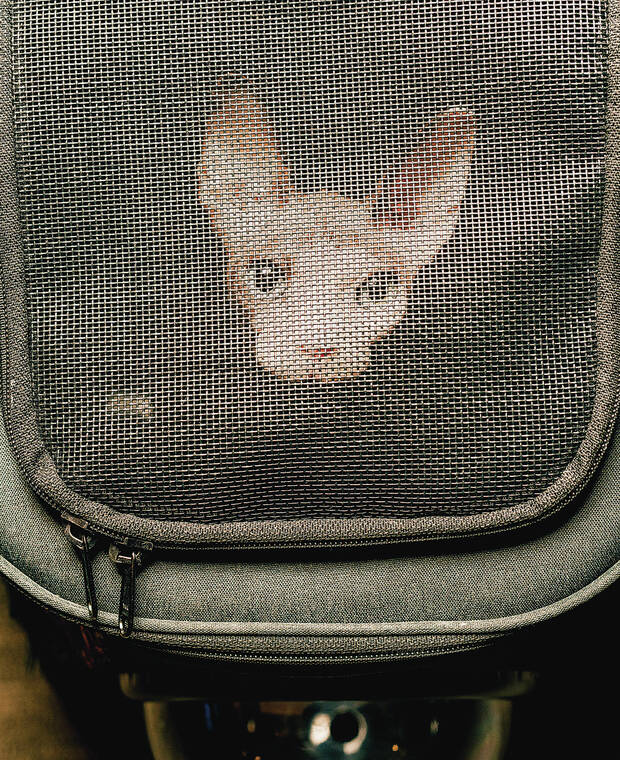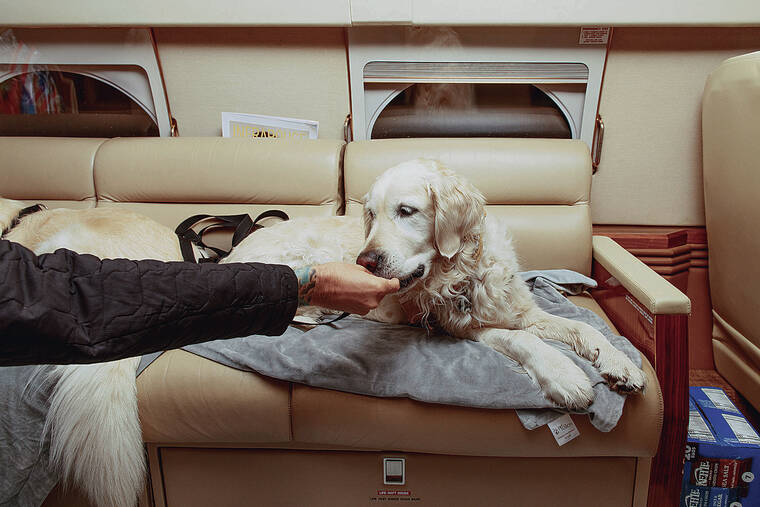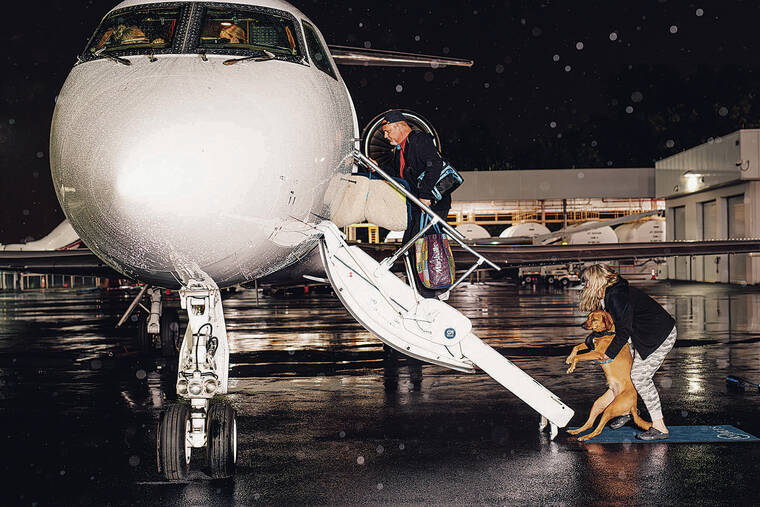A new airline caters to pampered pet passengers

NEW YORK TIMES
Bowie, a Sphinx, before boarding a K9 Jets flight to London at Teterboro Airport in Bergen County, N.J.

NEW YORK TIMES
Dee McLaughlin’s English cream retrievers, Murphy, left, and Bentley on a K9 Jets flight at Teterboro Airport in Bergen County, N.J.

NEW YORK TIMES
Nick and Michele Koutsoftas board a K9 Jets flight with Albert, their reluctant 2-year-old Rhodesian Ridgeback mix, at Teterboro Airport in Bergen County, N.J.



Last Friday evening, as drizzle fell on the tarmac, 10 passengers boarded a Gulfstream G4 headed from Teterboro Airport in New Jersey to Farnborough Airport, just southwest of London. They didn’t seem to notice the plush leather seats or the treats nestled in Champagne flutes in the armrests.
They also hadn’t particularly enjoyed clambering up the aircraft’s stairs.
This was the inaugural flight of K9 Jets, a private jet charter company based in Birmingham, England, founded in response to both a growing desire among pet owners to travel with their animals and mounting frustration at the increasingly challenging process of flying with them. The passenger manifest included nine dogs, mostly on the larger side, and one sphinx cat, as well as 10 humans.
Most of the people onboard were relocating to Europe. One said her Australian cattle dog mix, Jasmine, needed lifesaving heart surgery. All had one thing in common: an aversion to putting their pets in the cargo hold.
Pet owners seeking to transport their pets on commercial flights must navigate a patchwork of rules that vary by airline. Service animals, which are not considered pets, are allowed to be in the cabin and left unconfined, but other animals are subject to size restrictions that require bigger pets to travel as cargo, though some airlines won’t carry specific breeds.
Animals that can fly inside the cabin in carriers, which must fit under the seat in front of the passenger, can face seemingly arbitrary judgments about whether the carrier is big enough. Emotional support animals, which once were allowed in cabins, no longer are, according to the Federal Aviation Administration.
Don't miss out on what's happening!
Stay in touch with breaking news, as it happens, conveniently in your email inbox. It's FREE!
Many owners of larger dogs fear what might happen to pets shipped as cargo, where they could face fluctuating temperatures, poor ventilation and inappropriate handling.
More than 200 pets, the majority of them dogs, died on flights in the past decade, according to the U.S. Department of Transportation, which does not specify whether the pets were in cargo. The department has advised owners of snub-nosed dogs such as pugs and bulldogs to consider the risks of shipping those breeds as cargo, citing a far higher mortality rate than for other dog breeds.
Snub-nosed dogs more frequently encounter difficulty breathing, compared to other breeds, according to the American College of Veterinary Surgeons.
Last year, seven pets died during flights, according to Transportation Department data. Of these fatalities, six occurred on Hawaiian Airlines flights. Five of these animals were short-faced dogs shipped in cargo, said Marissa Villegas, a Hawaiian Airlines spokesperson.
Villegas said that before traveling on Hawaiian, passengers traveling with pets are required to acknowledge and accept the risks.
Private carriers step in
Meanwhile, private jet companies have stepped in, offering air travel for pets inside the plane without having them spend hours trapped in crates or carriers. Some, like NetJets and VistaJet, have dedicated pet programs. On VistaJet flights, pets are fed prime cuts of meat, offered toys and given a soft mat to sleep on.
Leona Qi, president of VistaJet U.S., said there’s been a steady rise in the number of people traveling with their pets and that about half of the company’s customers bring their animals along. Most are dogs, but she said there have also been rabbits, falcons and once, a chameleon. VistaJet sells memberships that offer different levels of access to flights. Madelyn Reiter, a spokesperson for the company, declined to detail prices.
Qi said that the pet program had frequently been “the determining factor” in convincing clients to upgrade to more expensive memberships that offer more cabin space.
On private flights, dogs less than 150 pounds are usually allowed to sit on an aircraft’s seats, although pets must be secured by a seat belt or placed in a carrier during taxi, takeoff and landing, private jet operators said. On some jets, once a person buys a seat, there is no additional cost to transport a pet or requirement to purchase a seat. Multiple companies even help clients navigate country-specific pet restrictions and assemble required documents for entry, another obstacle to flying internationally with pets.
But these private flights can be incredibly expensive, with a price tag that can run to tens of thousands of dollars, even for a domestic jaunt from one coast to the other.
For years, Rusty Rueff, a 62-year-old startup adviser and investor who lives in the San Francisco Bay Area, flew his dog across the country on Pet Airways, an airline founded in 2009 that carried only animals. But the company shut down several years ago.
Rueff said that while he’d flown privately with his 5-year-old French bulldog Theo several times during the pandemic, it wasn’t a practice he wished to continue. When he’d tried to fly commercially with a previous dog, also a French bulldog, they’d sometimes been prohibited from boarding the plane, he said. That uncertainty has made him reluctant to fly commercially with an animal.
Instead, his family drives across the country from the Bay Area to Rhode Island, where they have a summer place. He called the annual trip “a pain.”
“I just don’t understand why the airlines don’t recognize the business opportunity,” Rueff said. “We’ll do anything for our pets, just like we’ll do anything for our children.”
Big dogs in the cabin
K9 Jets hopes to capitalize on that feeling, initially offering flights between New York and Paris, London and Lisbon, Portugal. Of 17 listed flights between May and the end of September, eight are sold out. In the fall, the company may expand service to additional cities, including Dubai, United Arab Emirates. One-way tickets between New York and Europe hover around $9,000 per seat. Pet owners can purchase a seat for their pet; otherwise, the pets can sit on the floor for no charge. Pets cannot fly without human accompaniment.
Adam Golder, the founder of both K9 Jets and G6 Aviation, a private jet brokerage, said that they planned to add more summer flights in response to surging demand.
“There are hundreds of people that are waiting for a flight,” Golder said. “I think people don’t want to put them in a crate and wave goodbye to them.”
K9 does not actually own any planes. The flights are operated by licensed U.S. air carriers, including Pegasus Elite Aviation. K9 Jets is using Gulfstream G4 planes that can accommodate 10 passengers.
Dee McLaughlin and her partner James purchased two seats on K9 Jets’ inaugural flight last week. They were accompanied by Bentley and Murphy, their English Cream golden retrievers, who lounged serenely on a cream-colored sofa aboard the plane. They were en route to Ireland, where the family is relocating, from Los Angeles. To get to New Jersey, they’d taken four flights across two days on JSX, which offers public chartered flights to a limited number of domestic destinations and permits medium and large dogs in the cabin either in a carrier or on the floor.
McLaughlin said she’d “absolutely dreaded” putting the dogs in cargo. She researched alternatives for months, mining social media for tips on chartering a plane with other like-minded strangers. Then she discovered K9 Jets, which she called “a game changer for pet parents like us.”
“We feel really good because the dogs will be by our sides,” McLaughlin said. They eventually rented a private jet for the final leg of the trip, from London to Ireland. Their air travels would cost them more than $35,000.
Private jet footprints
Golder said that so far, the majority of prospective clients are relocating or traveling for long periods of time. Most human passengers on the company’s flight last week said they were flying private for the first time.
Private flights don’t come without an environmental cost. Research has shown that private jets emit far more carbon dioxide emissions per passenger than commercial planes do. According to Transport and Environment, an advocacy group based in Brussels, private jets are 5 to 14 times more polluting than commercial planes and 50 times more polluting than trains.
But some pet owners, like Ali and Mary Borzabdi, feel that they don’t have a choice. Mary Borzabdi and their dog, Jasmine, were on the K9 Jets flight to London last Friday. Jasmine, a sweet and excitable dog with serious heart disease, was nervous and wearing a diaper aboard the plane. In several weeks, she is scheduled for surgery in London.
“We don’t have children. All we’ve got is one dog,” Ali Borzabdi said. “You try everything and hopefully it works out.”
© 2023 The New York Times Company




